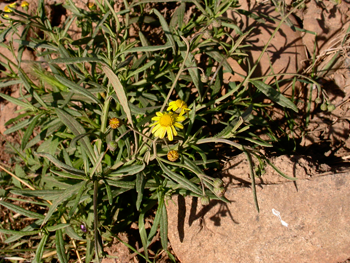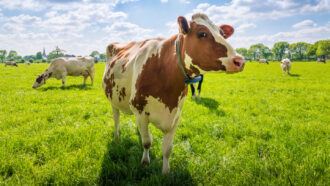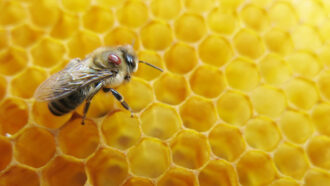Sheep poop may spread poisonous weed
Teen shows that using sheep to halt plant’s spread may do the opposite

Jade Moxey with some of the sheep on her parents’ farm in Australia. The teen studied the animals’ poop to see what happened after they ate an invasive plant.
Anne-Marie Moxey
LOS ANGELES, Calif. — Fireweed is invading Australia. The bright yellow plant, native to Africa, is poisonous and can harm cattle and horses. Sheep are resistant, though, and often are used to eat away at the problem. But are the sheep coming away poison-free? Jade Moxey, 17, decided to find out. And the findings by this senior at Sapphire Coast Anglican College in Australia turned up some surprises.
Although sheep may consume fireweed in one spot, they also spread the plant around, she found. And while the sheep may not suffer ill effects from the poisonous plant, its chemical weapons may end up in the sheep’s meat.
Jade shared her results here at the Intel International Science and Engineering Fair (ISEF). Created by Society for Science & the Public and sponsored by Intel, the competition brings together almost 1,800 high school students from more than 75 countries. (The Society also publishes Science News for Students and this blog.)
Fireweed (Senecio madagascariensis) looks like a bright yellow daisy. Sheep love to eat it. “When we put the sheep in a new paddock, they automatically go for the yellow flowers,” Jade says. The plant, also known as Madagascar ragwort, has spread as far as Australia, South America, Hawaii and Japan. But its pretty appearance hides a toxic secret. It makes chemicals called pyrrolizidine alkaloids (PEER-row-LIZ-ih-deen AL-kuh-loidz). They can cause liver damage and liver cancer in horses and cattle.

Sheep resist these poisonous effects, though, so they have seemed an ideal way to control the problem. Farmers let the animals loose in places where fireweed is a problem. And the sheep gobble it up.
But plant seeds can sometimes survive the digestion process. And Jade wondered what might be happening after the fireweed passed through the sheep’s gut. She collected manure twice from 120 sheep on her parents’ farm. She laid that poop out on the ground, protected it from stray breezes that might blow in seeds and waited. Sure enough, 749 plants grew. Of these, 213 were fireweed. So the sheep might be eating the weed, she concludes, but they’re also probably spreading its seeds.
Jade also was curious whether it was true that sheep are immune to the fireweed’s poison. Working with her local veterinarian, she tested blood samples from 50 sheep. She also examined the livers from 12 sheep to see if that organ had been damaged. Jade now reports that sheep have no need to fear the fireweed. Even animals that had grazed on fireweed for six years showed little sign of harm
That didn’t mean the poison wasn’t present, however. Very low levels of it turned up in the animals’ liver and muscle (that is, the meat), Jade found. Though the fireweed poison can be toxic to people, “the levels aren’t cause for concern,” she says. Indeed, she still eats local mutton (sheep meat) without worry.
But she might have reason to change her mind if those sheep were to eat more of the weed. “The fireweed on my property where the sheep were sourced from [has a density of] 9.25 plants per square meter [about 11 plants per square yard]. And in other areas of Australia there are densities up to 5,000 plants in a square meter [5,979 plants per square yard].” In those cases, sheep may eat a lot more of the plant. And then, Jade says, more testing should be done to find out how much ends up in the meat people eat.
UPDATE: For this project, Jade received a $500 award at Intel ISEF in the Animal Sciences category.
Follow Eureka! Lab on Twitter







